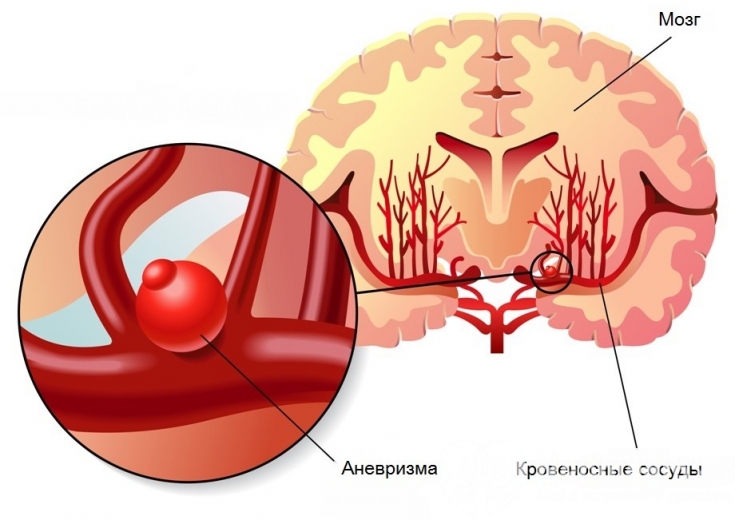The insidiousness of aneurysms is manifested in the absence of a clear clinical picture of the disease and the difficulty of detection. Symptoms of an aneurysm can be confused with signs of a brain tumor or stroke. The presence of an aneurysm in the brain or in the heart may not give any manifestations for months or even years. When this formation begins to increase in volume, the chances of an aneurysm rupture and death increase. Therefore, with constantly elevated blood pressure, with a feeling of tightness in the temples or chest, in the heart, one should be examined for the presence of aneurysms in the brain, heart, and abdominal cavity using special methods.
What is an aneurysm and how to live with it
Aneurysm – this is a congenital or acquired disease, which is a protrusion of the walls of the vessel or bulging due to the thinning of the wall. It affects the arterial walls, the branching of the vessels becomes a favorite place of localization. After birth, the presence of an aneurysm is often not diagnosed in a child, only in the process of the negative influence of the pathologies that have arisen in the body, this formation can grow, block nearby arteries and lead to hemorrhage. An aneurysm develops due to the absence of the submucosa and muscular layer of the vessel, can grow in a short time and sometimes causes pain. In the vessels, blood circulation occurs under high pressure, which provokes stretching of the wall of the damaged vessel, and an aneurysm occurs. For many years, an aneurysm may not manifest itself in any way, that is why it is called "time bomb" – will show itself anyway, it's a matter of time.
Causes and symptoms of the dangerous phenomenon
Since an aneurysm is most often congenital, the cause of its increase may be the presence of atherosclerosis or infections that contribute to the thinning of the walls of the arteries. Aneurysms can develop as a consequence of a genetic collagen deficiency, high blood pressure, trauma, or injury to the blood vessels. The main causes of aneurysms are: pathologies of the blood vessels, polycystic kidney, atherosclerosis, connective tissue disease, cholesterol deposits, infections, head injuries, hypertension, vascular disease, congenital aortic malformations, injuries to the abdominal cavity or chest.
Symptoms of an aneurysm are varied and depend on the type of disease. Aneurysm of cerebral vessels under the influence of high blood pressure begins to grow, and only then can a rich clinical picture appear, similar to a brain tumor: migraine, dizziness, impaired vision, hearing, coordination of movements, speech. Syncope often occurs after aneurysm rupture.
If the process of tissue repair is not started in time, then the rupture of the aneurysm entails death, coma or the loss of most of the vital functions, leading to disability.
For an abdominal aortic aneurysm, the main symptoms are a burning sensation in the chest or aching pain in the abdomen that cannot be clearly localized.
Also, symptoms of an aortic aneurysm may include:
• numbness or coldness of extremities,
• throbbing in the stomach or near the navel.
In the event of an aneurysm rupture, vomiting, nausea, and acute pain in the abdomen and lower back begin.
Aneurysm of peripheral vessels (vessels of the extremities) leads to constant pain in the arms, legs, knees. An aneurysm under the knee can interfere with flexion of the joint, causing severe pain and discomfort.
A cardiac aneurysm appears at the site of cardiosclerosis (post-infarction or infectious), its symptoms are heart failure, edema, shortness of breath, weakness, sputum stagnation in the bronchi, and rapid heartbeat.

Diagnosis and possible consequences of an aneurysm
Aneurysm can be identified by angiography, CT angiography, MR angiography, and Doppler ultrasonography. These methods make it possible to study the aneurysm, its size and possible consequences with high accuracy.
Rupture of an aneurysm leads to hemorrhage and leads to death if surgical intervention is not timely.
Even if the aneurysm was identified in advance and it did not have time to burst, an operation is required to excise the damaged part of the vessel, then it is replaced with a plastic prosthesis or a part of the vessel from another part of the body.
A person who has experienced a ruptured aneurysm may experience the following:
• impaired speech, vision, hearing;
• impaired mobility of the limbs;
• disturbance in the perception of information;
• epilepsy;
• constant headaches, pain in the limbs, in the chest;
• dysfunction of the excretory system.
Therefore, after an aneurysm rupture, it is important to start rehabilitation as soon as possible so that the hemorrhage entails less consequences.






Add a comment